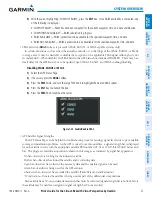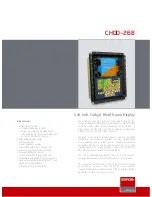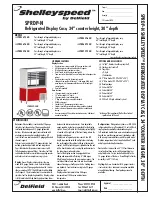
190-00820-11 Rev. A
Pilot’s Guide for the Cirrus SR2x with Cirrus Perspective by Garmin
33
SYSTEM OVERVIEW
SY
STEM
O
VER
VIEW
FLIGHT
INSTRUMENTS
EIS
AUDIO P
ANEL
& CNS
FLIGHT
MANA
GEMENT
HAZARD
AV
OID
ANCE
AFCS
ADDITIONAL
FEA
TURES
APPENDICES
INDEX
HSI. In addition, an amber ‘HDG’ annunciation with a red X appear above the ‘TRK’ annunciation to indicate
the HSI is displaying track instead of heading.
If both the heading and track are unavailable, the HSI displays an amber ‘HDG’ annunciation with a red X
over the heading readout box. The system also removes directional numbers and letters from the HSI.
Figure 1-21 Heading Failure Displays on the HSI
HSI Track Mode (Heading Unavailable, Track Available)
Heading and Track Unavailable
Failure of the air data input has no effect on the AHRS output while AHRS is receiving valid GPS information.
Invalid/unavailable airspeed data in addition to GPS failure results in loss of all attitude and heading information.
The AHRS (GRS 77) corrects for shifts and variations in the Earth’s magnetic field by applying the Magnetic
Field Variation Database. The Magnetic Field Variation Database is derived from the International Geomagnetic
Reference Field (IGRF). The IGRF is a mathematical model that describes the Earth’s main magnetic field and
its annual rate of change. The database is updated approximately every five years. See the Appendices for
information on updating the Magnetic Field Variation Database. The system will prompt the pilot on startup
when an update is available. Failure to update this database could lead to erroneous heading information being
displayed to the pilot.
GPS RECEIVER OPERATION
Each GIA 63W Integrated Avionics Unit (IAU) contains a GPS receiver. Information collected by the specified
receiver (GPS1 for the #1 IAU or GPS2 for the #2 IAU) may be viewed on the AUX - GPS Status Page.
Internal system checking is performed to ensure both GPS receivers are providing accurate data to the PFD.
In some circumstances, both GPS receivers may be providing accurate data, but one receiver may be providing
a better GPS solution than the other receiver. In this case the GPS receiver producing the better solution
is automatically coupled to the PFD. “BOTH ON GPS 1” or “BOTH ON GPS 2” are then displayed in the
Reversionary Sensor Window (see Appendix A) indicating which GPS receiver is being used. Both GPS receivers
are still functioning properly, but one receiver is performing better than the other at that particular time.
These GPS sensor annunciations are most often seen after system power-up when one GPS receiver has
acquired satellites before the other, or one of the GPS receivers has not yet acquired an SBAS (Satellite Based
Augmentation System) signal. While the aircraft is on the ground, the SBAS signal may be blocked by
obstructions causing one GPS receiver to have difficulty acquiring a good signal. Also, while airborne, turning
the aircraft may result in one of the GPS receivers temporarily losing the SBAS signal.
If the sensor annunciation persists, check for a system failure message in the Messages Window on the PFD.
If no failure message exists, check the GPS Status Page and compare the information for GPS1 and GPS2.
Discrepancies may indicate a problem.



































